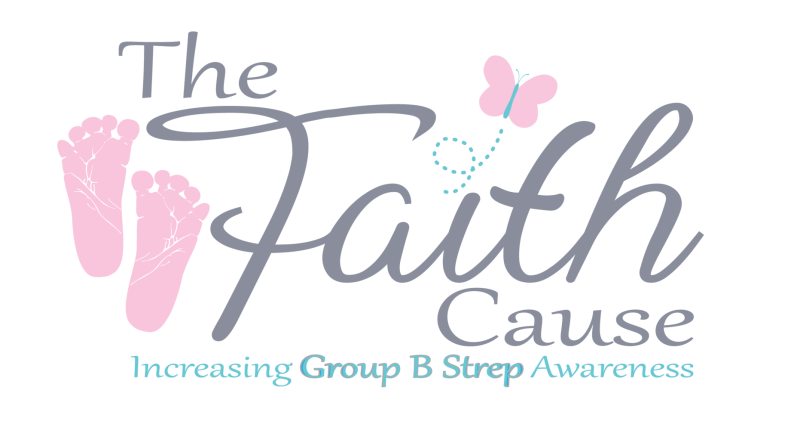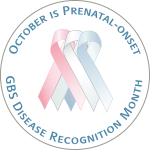
POGBS - Prenatal Onset GBS
The term “prenatal-onset GBS disease” was presented by GBSI at the Center for Disease Control and Prevention’s GBS Guideline Re-evaluation Meeting in June 2009 and then included on page 23 of the resulting guidelines for early-onset GBS disease prevention issued in the November 19, 2010 MMWR.
Previously there was no specific name given to GBS disease resulting in miscarriage or stillbirth, but pregnancy is a distinct time when unborn babies can become infected by GBS. In the UK although miscarriage and stillbirth due to GBS is recognised, it does not have a name.
Although there are no known ways to prevent prenatal-onset GBS infection, GBSI has identified three knowledge-based strategies and POGBS symptoms to help prevent babies becoming infected by group B strep before birth.
1) Urine culturing for GBS — When a pregnant woman has GBS in her urine (GBS bacteriuria), it means that she is likely to be heavily colonized vaginally where it can be moved closer to her baby. GBS bacteriuria is also known to put babies at greater risk for early-onset disease and the risk of preterm birth and rupture of the protective bag of water surrounding the baby can be doubled when there is a significant amount of GBS in urine. The following study shows that the risks of prematurity and premature rupture of membranes were reduced by penicillin treatment (at time of diagnosis) with continued follow-up, and retreatment if necessary: Thomsen AC, Morup L, Hansen KB. Antibiotic elimination of group-B streptococci in urine in prevention of preterm labour. Lancet 1987 Mar 14;1(8533):591-3.
2) Prompt attention to vaginal infections — GBS can cause vaginitis symptoms such as external vaginal burning and/or irritation as well as unusual discharge. These symptoms may be mistaken for a yeast infection and treated incorrectly. Please click here for medical abstracts on GBS vaginitis.
3) Use caution regarding invasive procedures and avoid membrane stripping — GBS can cross intact membranes and invasive procedures can help transport GBS closer to the baby.
Do not strip membranes (have a sweep) in the presence of GBS and here's why.
by Dr. James A. McGregor. This video contains ultrasound footage illustrating active uterine transport in both a non-pregnant and pregnant patient.
Please click here to view our article, “Prenatal-onset Group B Strep (POGBS) Disease: Giving a Name to Group B Strep Disease Acquired before Birth and Four Courses of Action to Help in Its Prevention,” first published on www.obgyn.net in 2006.
The Challenge of Fetal Mortality
MacDorman M, Kirmeyer S. The challenge of fetal mortality. NCHS data brief, no 16. Hyattsville, MD: National Center for Health Statistics. 2009.
Here's what GBSS have to say about membrane sweeps:-
There is currently no good evidence that membrane sweeps are harmful in women known to carry GBS. Indeed the results of trials of membrane sweeps don’t show any increase in problems caused by GBS in women having sweeps, and it is highly likely these trials would have included many women carrying GBS at the time.
However, there remains a theoretical risk that a membrane sweep might occasionally introduce GBS into the uterus, and so our medical advisory panel advises caution in using a membrane sweep for women known to carry GBS when there are other acceptable alternatives (for example, induction of labour with prostaglandin gel introduced into the vagina)
EOGBS - Early Onset GBS
Early-onset GBS infection in babies (0-6 days of life)
GBS infections which occur within the first week of life are called “early-onset” GBS infection.
In the UK, up to 75% of GBS infections are early onset (apparent within the first week), although assuming that current risk-based prevention prevents a significant proportion of infections, then without such preventative medicine, the figure is likely to be nearer 90%. It is the early-onset GBS infections that are potentially preventable when Mum is given intravenous antibiotics in labour.
Early onset GBS infection usually presents as septicaemia with pneumonia. These “early-onset” infections are usually apparent at or soon after birth, with the typical symptoms of early-onset GBS infection including:
-
grunting
-
lethargy
-
irritability
-
poor feeding
-
very high or low heart rate
-
low blood pressure
-
low blood sugar
-
abnormal (high or low) temperature; and
-
abnormal (fast or slow) breathing rates with blueness of the skin due to lack of oxygen (cyanosis).
LOGBS - Late Onset GBS
Late onset GBS infection in babies age 6 days to 3 months
Up to 25% of GBS infections are late-onset, occurring after the baby’s first 6 days, usually as meningitis with septicaemia. It is uncommon after a baby reaches one month old and very rare after age three months. Currently there are no known ways of preventing late-onset GBS infections so identifying signs and symptoms of these infections is vital for early diagnosis and treatment.
Late onset GBS infection usually presents as septicaemia, pneumonia and/or meningitis. Typical signs of late-onset group B Strep infection are similar to those associated with early onset infection and also include signs associated with meningitis such as:
-
Being irritable with high pitched or whimpering cry, or moaning
-
Blank, staring or trance-like expression
-
Floppy, may dislike being handled, be fretful
-
Tense of bulging fontanelle (soft spot on babies’ heads)
-
Turns away from bright light.
-
Involuntary stiff body or jerking movements
-
Pale, blotchy skin
There are currently no prevention protocols in place to help prevent late-onset GBS infection. However, being able to recognize the symptoms of GBS infection in babies is imperative for prompt medical treatment for better outcomes. GBS is a very fast-acting type of bacteria and an otherwise healthy-appearing baby can become critically ill within a matter of hours.
If a baby shows signs consistent with GBS infection or meningitis go immediately to your nearest Paediatric Casualty Department.
If a baby has late-onset GBS infection or meningitis, early diagnosis and treatment are vital: delay could be fatal.
More information on POGBS collated by Kim Poulton
Below is information collated me, baby Faiths Mum specific to POGBS. This was passed on to my consultant when questioning why POGBS is not recognised here in the UK.
Amazingly my consulatant has written to The Royal College of Obstetricians and Gynaecologists (RCOG) and asked "if the time is now ripe for them to review and amend their guidelines"
http://www.nhs.uk/conditions/Streptococcal-infections/Pages/Introduction.aspx
Strep B in pregnancy
It's estimated around one in every four pregnant women have strep B bacteria in their vagina or digestive system.
The bacteria can sometimes be passed on to the baby through the amniotic fluid (a clear liquid that surrounds and protects the unborn baby in the womb) or as the baby passes through the birth canal during labour.
Most babies exposed to strep B will be unaffected, but in around 1 in every 2,000 cases they can become infected.
A strep B infection during pregnancy can also cause miscarriage or stillbirth, but this is rare.
http://www.nhs.uk/chq/Pages/2037.aspx
What are the risks of group B streptococcus (GBS) infection during pregnancy?
Extremely rarely, GBS infections during pregnancy can also cause miscarriage, early (premature) labour or stillbirth.
http://www.nhs.uk/Conditions/Stillbirth/Pages/Causes.aspx
Causes of stillbirth - Infections
Around one in 10 stillbirths are caused by an infection. The most common type of infection is a bacterial infection that travels from the vagina into the womb (uterus). These bacteria include group B streptococcus,
http://gbss.org.uk/who-we-are/about-gbs/what-is-gbs/faqs/
Are membrane sweeps safe for women who carry GBS?
There is currently no good evidence that membrane sweeps are harmful in women known to carry GBS. Indeed the results of trials of membrane sweeps don’t show any increase in problems caused by GBS in women having sweeps, and it is highly likely these trials would have included many women carrying GBS at the time.
However, there remains a theoretical risk that a membrane sweep might occasionally introduce GBS into the uterus, and so our medical advisory panel advises caution in using a membrane sweep for women known to carry GBS when there are other acceptable alternatives (for example, induction of labour with prostaglandin gel introduced into the vagina)
http://www.ncbi.nlm.nih.gov/pubmed/?term=3290476
Perinatal group B streptococcal infections across intact amniotic membranes.
We reviewed the perinatal mortality due to group B streptococcal infection over a three-year period at a tertiary center. In 6 of 16 perinatal deaths due to group B Streptococcus, representing a range of gestational ages, infection occurred with the membranes intact. A review of reports from the obstetric and pediatric literature revealed that 10-50% of group B streptococcal infections occur in this manner.
http://www.gbss.org.uk/filepool/2012_07_13_The_Facts_4_HealthProfessionals.pdf
Pre-birth Complications & GBS 2.3.1 Stillbirth and late miscarriage along with many other bacteria found in the vagina, GBS can cause infection in a baby whilst still in the womb, which can cause stillbirth. GBS can live in amniotic fluid and from here can spread into the baby’s lungs and, from there, into the baby’s bloodstream where they may cause infection, which can result in the baby’s death. Bacteria will most probably have been passed from the mother to her baby before or during delivery
The 3 ways in which a baby becomes infected with GBS are: 2.5.1 Before birth There are physical and chemical barriers to keep bacteria from getting inside the baby, including the cervical canal, the mother’s immune system and the amniotic fluid. If GBS get inside the baby, they will normally be attacked by the baby’s immune system, although GBS can sometimes foil this immunological attack. In pregnant women who carry GBS, the bacteria can travel from the mother’s vagina into the baby’s bloodstream. To do this, they cross the cervix and have an enzyme, called hyaluronate lyase50, which can punch microscopic holes in apparently intact amniotic membranes, normally without causing any sign or symptom of these rupturing. Unlike many bacteria, GBS can live in amniotic fluid and from here spread into the baby’s lungs and into the baby’s bloodstream, where they may set up an infection46. At each stage of the journey, the bacteria come up against the mother’s or baby’s natural defences and, the vast majority of times, invasion is prevented. However, when infected with GBS before birth, none of these natural defences has protected the baby, who develops early onset infection. Once an infection has developed, this can lead to shock (a dangerous reduction of blood flow throughout the body tissues that, if untreated, may lead to collapse, coma and death.
http://www.obgyn.net/articles/prenatal-onset-group-b-strep-pogbs-disease
Prenatal-onset Group B Strep (POGBS) Disease
Group B strep (GBS) can definitely infect babies before birth, yet there is not an official name designated for GBS disease when it causes babies to be miscarried or stillborn. To further awareness and prevention of GBS disease in all stages of a baby’s development, Group B Strep International is giving a name to GBS disease acquired before birth: Prenatal-onset Group B Strep (POGBS) Disease.
However, a baby can definitely succumb to GBS infections long before the bacteria are transmitted during delivery. Since this is not yet a recognized disease it is unknown how many babies have been miscarried or stillborn due to GBS. Pathology testing is not mandatory and not even always suggested to the mother. At minimum, placental culturing may tell the cause of death. This is important especially since having a baby infected by GBS puts a mother at higher risk for subsequent babies being infected by GBS.
Perhaps the reason that prenatal-onset GBS disease has not been officially recognized is that the general medical opinion considers GBS-caused miscarriages and stillbirths to be
rare occurrences. However, among GBS awareness groups, there are far too many parents who have had their baby’s autopsy or placental testing report cite GBS as the cause of death for prenatal-onset
GBS disease to continue being regarded as rare.
, GBS may be introduced to the baby during routine cervical checks and other invasive procedures such as intrauterine fetal monitoring, application of cervical ripening medications, and “membrane
stripping” sometimes known as “membrane sweeping.”
Membrane stripping can introduce infection5 although there is a debate about whether or not it is directly related to a higher incidence of GBS infection. However, it has
been proven via dye tests that small particles can ascend through the cervix. Case studies of dead or very sick babies at birth point to a direct correlation. Common sense alone dictates that if a
gloved hand or instrument is moved through the lower third of the vagina (where GBS usually colonizes) and then up into the cervix that GBS or other bacteria can be moved closer to where the baby can
be harmed. A recent legal case examines the potential for litigation regarding membrane stripping.6
http://www.groupbstrepinternational.org/what-is-group-b-strep/prenatal-onset-3/
The term, “prenatal-onset GBS disease” was presented by GBSI at the Center for Disease Control and Prevention’s GBS Guideline Re-evaluation Meeting in June 2009 and then included on page 23 of the resulting guidelines for early-onset GBS disease prevention issued in the November 19, 2010 MMWR. Previously there was no specific name given to GBS disease resulting in miscarriage or stillbirth, but pregnancy is a distinct time when unborn babies can become infected by GBS.
Although there are currently no prevention guidelines in place for prenatal-onset GBS disease, GBSI has identified three knowledge-based strategies to help prevent babies becoming infected by group B strep before birth.
GBS can cross intact membranes and invasive procedures can help transport GBS closer to the baby. Please click here for medical abstracts on the risk of infection due to invasive procedures.
http://www.groupbstrepinternational.org/about-gbsi/
The mission of Group B Strep International (GBSI) is to promote international awareness and prevention of Group B Strep (GBS) disease in babies before birth through early infancy.
https://www.rcog.org.uk/en/guidelines-research-services/guidelines/gtg36/
Group B streptococcus (Streptococcus agalactiae) is recognised as the most frequent cause of severe early-onset (at less than 7 days of age) infection in newborn infants. However, there is still controversy about its prevention.
http://legacy.screening.nhs.uk/groupbstreptococcus
The UK NSC recommendation on Group B Streptococcus screening in pregnancy
GBS is one of many bacteria that can be present in our bodies. It usually causes no harm. This situation is called carrying GBS or being colonised with GBS. GBS is commonly found in the digestive system and the female reproductive system. It's estimated that about one in four pregnant women in the UK carry GBS.
Around the time of labour and birth, many babies come into contact with GBS and are colonised by the bacteria. Most pregnant women who carry GBS bacteria have healthy babies. However, there's a small risk that GBS can pass to the baby during childbirth. Rarely, GBS infection in newborn babies can cause serious complications that can be life-threatening.
Extremely rarely, GBS infection during pregnancy can also cause miscarriage, early (premature) labour or stillbirth. If a baby develops GBS infection less than seven days after birth, it's known as early-onset GBS infection. Most babies who become infected develop symptoms within 12 hours of birth. It's estimated that about one in 2,000 babies born in the UK and Ireland develops early-onset GBS infection. This means that every year in the UK (with 680,000 births a year) around 340 babies will develop early-onset GBS infection.
http://www.sciencebasedbirth.com/ObGynNews%2001a/OBN%20Cx%20manip%20leads%20infection%20Oct01.html
In a series of eight case reports, Dr. Stamm of the University of Colorado, Denver, described how cervical manipulation or membrane stripping preceded perinatal sepsis and even one instance of stillbirth caused by invasive group B streptococcus (GBS) as well as other pathogens.





